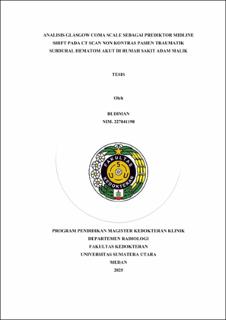| dc.contributor.advisor | Harahap, Evo Elidar | |
| dc.contributor.advisor | Arsyad, Abdurrahman Mousa | |
| dc.contributor.author | Budiman, Budiman | |
| dc.date.accessioned | 2025-06-30T04:18:07Z | |
| dc.date.available | 2025-06-30T04:18:07Z | |
| dc.date.issued | 2025 | |
| dc.identifier.uri | https://repositori.usu.ac.id/handle/123456789/104699 | |
| dc.description.abstract | Background: Head injury is a serious medical condition that can lead to neurological dysfunction and potentially fatal outcomes, especially in cases of acute traumatic subdural hematoma (SDH). The Glasgow Coma Scale (GCS) is commonly used to assess the severity of head trauma; however, it is not sufficiently accurate for predicting midline shift (MLS) without imaging support. MLS can be detected through imaging modalities such as Computed Tomography (CT) scan or Magnetic Resonance Imaging (MRI) and serves as an important indicator of the patient's clinical condition. Significant MLS may indicate critical conditions such as cerebral edema or large hematomas. Nonetheless, deciding whether to proceed with immediate surgery or observation in patients with moderate MLS and thick hematomas remains a clinical challenge. Therefore, this study aims to analyze the sensitivity and specificity of GCS in predicting MLS in patients with acute SDH.
Methods: This study employed an analytical observational design with a diagnostic test approach. Subjects were patients diagnosed with acute traumatic SDH who underwent non-contrast head CT scans. Data were collected to assess the correlation between GCS scores and MLS values and to determine the GCS cut-off point for predicting MLS.
Results: Among 34 patients, the majority were male (76.5%) and aged between 18–34 years (35.3%). Most patients had a GCS score of 9–13 (38.2%) and showed subarachnoid hemorrhage on CT scan (44.1%). A strong correlation was found between lower GCS scores and increased MLS. The mean MLS increased significantly with decreasing levels of consciousness. The GCS cut-off score to differentiate significant MLS was 13, with a sensitivity of 100%, specificity of 79.3%, positive predictive value of 87%, and negative predictive value of 85%.
Conclusion: GCS has a strong correlation with MLS and can be used as a reliable clinical indicator to predict MLS in patients with acute traumatic SDH. A GCS score of ≤13 indicates a higher likelihood of significant MLS and may serve as an early guide for management decisions, particularly in healthcare settings with limited access to CT scan facilities. | en_US |
| dc.language.iso | id | en_US |
| dc.publisher | Universitas Sumatera Utara | en_US |
| dc.subject | Glasgow Coma Scale | en_US |
| dc.subject | Midline shift | en_US |
| dc.subject | Acute subdural hematoma | en_US |
| dc.subject | CT scan | en_US |
| dc.subject | Head injury | en_US |
| dc.title | Analisis Glasgow Coma Scale sebagai Prediktor Midline Shift pada CT Scan Non Kontras Pasien Traumatik Subdural Hematom Akut di Rumah Sakit Adam Malik | en_US |
| dc.title.alternative | Analysis of Glasgow Coma Scale as a Predictor of Midline Shift on Non-Contrast CT Scan in Patients with Acute Traumatic Subdural Hematoma at Adam Malik Hospital | en_US |
| dc.type | Thesis | en_US |
| dc.identifier.nim | NIM227041198 | |
| dc.identifier.nidn | NIDN8918150022 | |
| dc.identifier.nidn | NIDN0002108601 | |
| dc.identifier.kodeprodi | KODEPRODI11103#Ilmu Kedokteran Klinis | |
| dc.description.pages | 87 Pages | en_US |
| dc.description.type | Tesis Magister | en_US |
| dc.subject.sdgs | SDGs 4. Quality Education | en_US |


